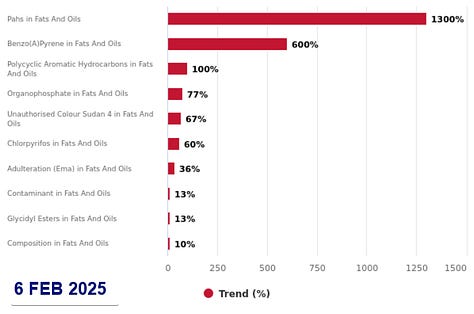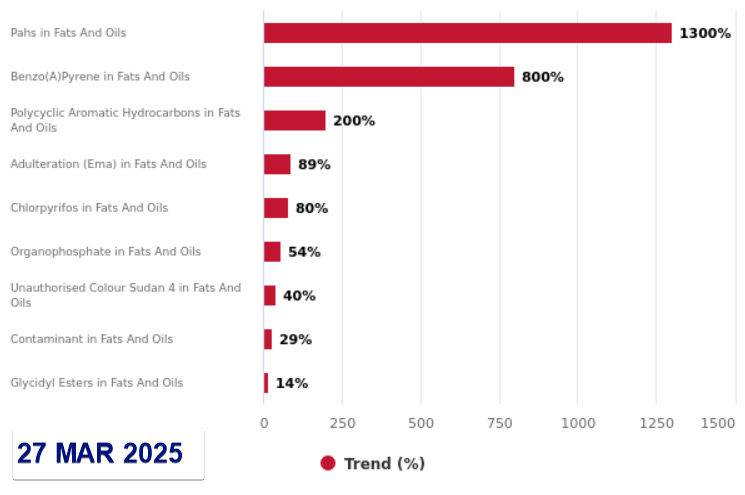183 | Trending hazards in fats and oils | Codex de-mystified |
Plus, cauliflower icecream: coming to a store near you
This is The Rotten Apple, an inside view on food fraud and food safety for professionals, policy-makers and purveyors. Subscribe for insights, latest news and emerging trends straight to your inbox each Monday.
What is Codex (exactly)?;
AI-assisted food safety insights for fats and oils;
Food Safety News and Resources;
Cauliflower ice cream (yum?)
Food fraud news, emerging issues and recent incidents.
Hello, lovely readers,
If you’re part of the US regulatory system, our hearts go out to you as you endure crippling uncertainty about the future.
Job losses at the FDA have occurred in departments responsible for inspections, foodborne illness investigations, chemicals research and freedom of information requests, leading to former commissioner Robert Califf stating the food program “is finished”.
“The FDA as we’ve known it is finished, with most of the leaders with institutional knowledge and a deep understanding of product development and safety no longer employed” Robert Califf via Food Safety News.
This week’s issue answers the niggling question “What (exactly) is Codex?”, in plain language, and includes insights about trending alerts for fats and oils.
The food safety news roundup is big with unusual outbreaks, recalls and alerts, an alarming study about microplastics in chewing gum plus much more.
As always, this issue ends with food fraud news and incidents behind the paywall. Because being a paid subscriber means getting access to the good stuff. And supporting this reader-funded publication.
Thank you!
P.S. Massive 👏👏👏 shout-out 👏👏👏 to Maria from a major bakery ingredient supplier in Australia who just renewed her team’s subscriptions. Maria and colleagues: thank you.
This newsletter would not be possible without paying subscribers like Maria. Learn more about paid subscriptions and group discounts here.
Cover image: Trending hazards in fats and oils by FoodAkai
What (exactly) is Codex?
So we all know what Codex is, right? Erm yeah, of course. It’s a global thing about food, right? A rule? Or guidelines? Maybe more like a handbook? Or perhaps it’s an organisation, a bunch of technical committees or standards writers?
Okay. Maybe some of us aren’t so sure about Codex.
Food safety trainers are always going on about Codex but no one ever seems to explain what it is. I’m here to fix that. In this article you get a fast, focused explanation of what Codex is and how its rules and guidelines are applicable to the work of food professionals.
What is Codex
In the context of food systems, Codex is short for Codex Alimentarius, which means ‘Food Code’ in Latin.
Codex Alimentarius is a group of documents: internationally recognised food standards and related texts, including codes of practice, guidelines and recommendations.
The Codex Alimentarius - the group of documents - is operated by the Codex Alimentarius Commission, an international standard setting body established by the Food and Agriculture Organization (FAO) and World Health Organization (WHO) in 1963.
Other international standard setting bodies include the International Organization for Standardization (ISO) and the International Maritime Organization (IMO) for shipping.
The Codex Alimentarius Commission exists to
Protect consumer health
Ensure fair trade practices, and
Promote the development of food safety standards.
The Codex Alimentarius Commission is a group of members, which are mostly countries. The commission consists of 188 member countries plus the European Union, for a total of 189 members.
That’s pretty much the whole world. For context, there are 195 countries in the world, 197 if you include Taiwan and Kosovo. Membership of the Codex Alimentarius Commission covers 99% of the world’s population and food production. Countries which are not members include Liechtenstein, Palestine, the Holy See, and Taiwan.
It’s fair to say the Codex Alimentarius Commission is truly global.
The Codex Alimentarius includes
standards for all foods for distribution to consumers, including unprocessed foods
standards for some food commodities (raw materials) that aren’t distributed directly to consumers
codes of practice, guidelines and related texts which cover
Food hygiene
Food additives
Residues of pesticides and veterinary drugs
Contaminants
Labelling and presentation
Methods of sampling and analysis
Import and export inspection and certification.
For example, if you want to know the definition, essential components and quality factors of honey, according to an internationally accepted standard, you could look up the Codex standard for honey. If you’re a law-maker, you could use the standard to develop a legal definition of honey for your country.
How does Codex work, from a legal point of view?
Codex texts are designed for countries to adopt into law, but doing so is voluntary. Codex standards and codes of practice have no binding effects on national food laws or nations. The World Trade Organization (WTO) encourages WTO members to use Codex standards to harmonise national regulations between countries.
The Codex Alimentarius Commission is operated by a collection of committees, including an Executive Committee; general committees, such as the Food Additives Committee and the Food Labelling Committee; and commodity-specific committees, such as the Fish and Fishery Products Committee and the Sugars Committee.
It also includes ad-hoc intergovernmental task forces, such as the Antimicrobial Resistance Task Force and regional committees.
When new standards and documents are developed, they are done so through and by the committees, with the input of scientific advice from organisations such as JECFA (Joint FAO/WHO Expert Committee on Food Additives) and JEMRA (Joint FAO/WHO Expert Meetings on Microbiological Risk Assessment), and through ad hoc expert consultations.
Where is the Codex Alimentarius?
The headquarters of the Codex Alimentarius Commission are in Rome, Italy, within the headquarters of the Food and Agriculture Organization (FAO).
The Codex Alimentarius Commission has a website published in various languages, where all standards, codes of practices and guidelines are available to download for free.
Website | CODEX ALIMENTARIUS FAO-WHO
What is Codex HACCP?
Codex HACCP is a nickname for a risk-based approach to food safety titled Hazard Analysis and Critical Control Point (HACCP), as defined and documented by the Codex Alimentarius Commission.
The approach is described in 7 principles, outlined in an appendix to the Codex Code of Practice General Principles of Food Hygiene (CXC 1-1969). The principles are accompanied by guidance about how they should be implemented by food businesses.
For example, a section titled ‘Application’ lists steps for food businesses to follow when creating a HACCP plan, starting with Step 1: Assemble HACCP team, progressing through steps 6 and 7: Identify hazards and determine critical control points; and finishing with step 12: Establish documentation and record keeping.
Codex HACCP is not…
Codex HACCP is not a standard. It is not a list of requirements, but instead defines the principles for creating a food safety plan and provides recommendations for implementing the principles in a food business.
Codex HACCP is not a standalone solution to food safety. It must be implemented alongside Prerequisite Programs (PRPs), such as good hygiene practices (GHPs) and good manufacturing practices (GMPs), which address site-wide food safety controls like sanitation, pest control, and personnel hygiene to create a complete food safety program.
Codex HACCP is designed to primarily address hazards arising from unintentional contamination and does not explicitly address intentional adulteration events, such as those perpetrated to cause harm or for economic gain.
Codex HACCP does not cover all the elements in a modern food safety management system, which also includes programs to address food safety culture, food fraud and food defence.
Where to find Codex HACCP?
The Codex Alimentarius document that describes the 7 principles of HACCP is General Principles of Food Hygiene (CXC 1-1969). The document includes an annex titled Hazard Analysis and Critical Control Point (HACCP) System and Guidelines for its Application, which outlines the seven principles of HACCP and provides guidance on its implementation (pages 23 to 37 of CXC 1-1969).
General Principles of Food Hygiene CXC 1-1969 | Codex Alimentarius Commission
For languages other than English, navigate to https://www.fao.org/fao-who-codexalimentarius/codex-texts/codes-of-practice/ and click on the ✔checkmark in the appropriate language column.
What is a Codex HACCP certificate?
The Codex Alimentarius Commission does not perform audits or provide certifications or training for food businesses. However, certification bodies can develop certification schemes and issue certificates based on the principles of HACCP as described in the Codex Alimentarius.
In short…
Codex is short for Codex Alimentarius, which means ‘Food Code’. It’s a collection of documents about food, food safety and the phytosanitary aspects of food supply chains, which were created by an international standard setting body to protect consumer health, ensure fair trade practices and promote the development of food safety standards. The 7 principles of HACCP are described in an appendix to General Principles of Food Hygiene (CXC 1-1969), which is a part of the Codex Alimentarius.
Website | CODEX ALIMENTARIUS FAO-WHO
Food Safety Insights Supported by AI
AI. Artificial Intelligence. It’s such a hot topic. But when I sit down to write about it, I rarely find anything to say that will be genuinely helpful or insightful.
In Issue 96, I attempted to navigate the hype about AI in food systems to bring you actual use cases. Find that article here: AI in Food Systems: Real-world Use Cases.
And in Issue 83 I published a slightly unhinged rant about my experiences with ChatGPT. Read that here: No Robots Allowed | Issue 83.
Since then, however, a lot has changed. AI and the software that uses it have come a long way. More AI-based apps have been developed and existing apps improved. In food safety, the popularity of AI-based risk assessment and horizon scanning tools is growing.
One AI-based risk assessment tool is FoodAkai, which calls itself “a food safety intelligence platform that monitors & forecasts risks across your supply chain”.






FoodAkai uses AI data analysis to forecast food safety risks for food commodities and ingredients (Disclaimer: I have no financial affiliation with FoodAkai).
FoodAkai is similar to other ‘big data’ risk monitoring tools in that it combines a lot of information from many different sources to attempt to create insights into risks and trends for various ingredients and commodities.
I’m mentioning FoodAkai specifically, rather than one of the other tools, because I’ve been receiving free emailed updates from the FoodAkai platform for food safety trends in fats and oils this year.
Thought you would be interested in what I’ve learned, so today I’m sharing a high-level view of hazards and risks in fats and oils from January 2025 to today.
The hazards that are trending upwards for fats and oils, according to FoodAkai, are:
Polycyclic aromatic hydrocarbons
Benzol(A)pyrene
Economically motivated adulteration
Chlorpyrifos
Unauthorised colour Sudan 4
Organophosphate
Pesticides
Glycidyl esters
Separately, the top 4 risks for fats and oils, according to FoodAkai’s ‘Increasing Risks’ tables are mineral oil, improper import declarations, flupyram and dioxin.
How is this information used?
That depends, of course, on the type of business accessing the data. For most food businesses, the hazard and risk alerts and forecasts provided by tools like FoodAkai are used to help ensure that incoming ingredients are safe.
For example, if the tool warns us about increasing incidences of contamination with polyaromatic hydrocarbons, we could check and update our purchasing specifications, supplier approvals programs and laboratory tests to specifically address that issue so that any contaminated oil is identified and rejected before being used in our products.
Similarly, for economically motivated adulteration of fats and oils, which is trending upwards according to the FoodAkai reports, information from the tool should prompt us to review our food fraud vulnerability assessments for oils and make sure we have appropriate mitigations in place.
When it comes to keeping an eye on current suppliers or assessing a new supplier, FoodAkai, like most AI tools, also monitors businesses and can be used to discover whether suppliers, subsidiaries or competitors have been involved in product recalls or border rejections.
Final thoughts
In a world of information overload, AI-based systems can do some of the heavy lifting for us. They collect huge quantities of food safety data from publicly available alerts and can organise and filter the data according to individual users’ needs, making them a useful tool for discovering insights into ingredients, foods and supply chains.
However, as with any tool, the true value comes from the actions we choose to take in response to what we learn.
Side bar: What are polycyclic aromatic hydrocarbons (PAH) and mineral oil aromatic hydrocarbons (MOAH)?
Polycyclic aromatic hydrocarbons (PAH) and mineral oil aromatic hydrocarbons (MOAH) are found in mineral oils - that is, non edible oils derived from crude oil.
Mineral oils get into food as contaminants from the environment, from machinery - particularly machine lubricants - and from food packaging and printing ink. Mineral oils are also intentionally added to food and feed as additives and through their use as processing aids, such as dust binding agents or release agents.
Mineral oils that are designed for use in or near food are treated to minimise the amount of MOAH they contain, because MOAH are suspected carcinogens. Another class of mineral oil hydrocarbon is MOSH, mineral oil-saturated hydrocarbon, which accumulates in human tissues and can harm the liver.
PAH is a subset of MOAH, with a specific chemical structure and known carcinogenic properties.
Learn more about MOAH
🍏 We’ll be hearing about AI for food fraud prevention in next month’s live training session. Stay tuned for details 🍏
Food Safety News and Resources
My food safety news and resources posts have no fluff, no filler, no ads, no promos, no junk, just expertly hand-curated food safety news from around the globe, brought to you each week.
Lots of news this week, including scary research about microplastics released from chewing gum, unusual recalls, outbreaks and safety alerts, two food safety research papers and regulatory news from West Virginia and Australia, including the banning of food dyes.
Click the preview below to read.
Cauliflower Icecream (yum?)
A New Zealand brand that developed cauliflower ice cream for dairy-free, allergen-sensitive consumers is taking their wares to the USA.
Their products sold out in New Zealand stores within weeks of launch and demand for the vegan, vege-based desserts is strong in the US market. The company, EatKinda, is now looking for a US-based manufacturer to help it increase production capacity and reduce inefficiencies in the manufacturing process.

EatKinda | On a mission to help the world eat differently
Below for paying subscribers: Food fraud news and incident reports
In this week’s food fraud news:
📌 Food fraud risks from tariffs;
📌 Adulteration in tomato paste;
📌 Waste animal byproducts diverted to human food;
📌 Bulk milk thefts (2 countries), wine fakery, counterfeit coffee and more.
📌 Food Fraud News 📌
Tariff-related food shocks at home (USA)
The United States’ domestic food system is braced for shocks from newly imposed tariffs on imported food. Food is at a record trade deficit level – meaning the US is currently importing more food, by dollar value, than it exports, leaving it vulnerable to price rises on imported foods.

Foods affected by the tariffs can expect an increased likelihood of fraudulent activity such as smuggling, falsfied documentation (origin), counterfeiting, and include







